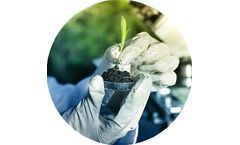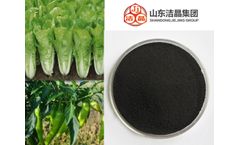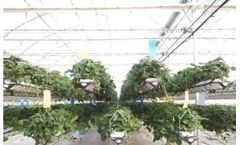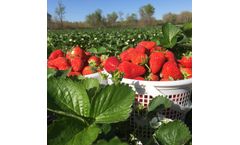Refine by
Agrochemical Articles & Analysis
40 articles found
Adjuvants: Used to enhance the effectiveness of other agrochemicals. Plant Growth Regulators: Gaining popularity for managing plant growth effectively. 2. ...
The NMR analysis for agrochemicals include, but are not limited to the following. Analysis of active ingredients in agrochemicals Active ingredients in agrochemicals are the key components that determine the effectiveness of a product against a specific pest or disease. ...
Plastic Applications for Agriculture Plastics have a variety of applications in the agriculture industry, including but not limited to: Mulch films for cereal crops Bulk bags for crop transportation Veterinary medicine containers Hoses and nozzles for irrigation Plastic bags for grain storage Solid fertilizer containers Seed packaging Net to tie bales Plastic film to cover horizontal silos and ...
It can increase production efficiency by adapting crop inputs, notably fertilizers and agrochemicals, to changing local circumstances within a field and collecting site-specific data on crop growth and yield-affecting factors. ...
And the results of a large number of compounding experiments of brown algae polyphenols with other agrochemicals approves that brown algae polyphenols can be compounded with specific amino acids, humic acid, macro, medium and trace elements and other agrochemicals to produce preparation products. ...
The blueberry (Vaccinium corymbosum) is a fruit highly appreciated for its intense flavor and color in the gastronomy of many countries. It is a climacteric fruit that surprisingly behaves like a non-climacteric fruit. This is because, once harvested, its respiration rate drops considerably. Blueberries are usually transported and marketed in micro-perforated clamshell boxes to avoid bruising ...
Hydroponic techniques emerged as a solution to the issues of growing directly on soil. Depending on the needs, the climate zone, the greenhouse and type of cultivation, we will be interested in working or not with a hydroponic ...
Fruit growers among other agriculture growers across the world are looking to surmount the challenge of increasing crop production with a dramatic reduction of synthetic agrochemical use and a reduction of environmental nutrient leaching in ground water and surface water sources. ...
Outbreaks of locust swarms in Africa, Asia and the Middle East have epitomised the essential need for indoor farming. Unseasonal rains caused by global warming, have aided the spread of desert locusts which would normally have died out in the dry season. Ethiopia and Somalia are currently experiencing their worst outbreak in twenty-five years, while Kenya is experiencing its worst infestation in ...
Abstract : The effects of three common agrochemicals, lindane, methyl parathion and atrazine, on crustaceanDaphnia magna, algaSelenastrum capricornutumand marine bacteriumVibrio fischeriwere investigated in this study. ...
On July 23, 2019, the Agencia Nacional de Vigilancia Sanitaria (ANVISA -- National Sanitation Surveillance Agency) in Brazil approved measures that clarify the toxicological classification of agrochemicals. Under the approved rules, the evaluation criteria of agrochemicals’ toxicity categories are established and label requirements are updated to include ...
Given the existence of two opposite interests in one area, maintaining balance between the nature and human activity is essential. Agricultural inputs– agrochemicals cause groundwater pollution all over the world, nitrate and phosphate in particular as a result of excessive fertilizer use or inadequate disposal of manure. ...
While a large focus is rightly placed on agrochemicals such as bio fertilisers and soil adjuvants, the correct water input is also vital to maximum efficiency and yield on the farm. ...
High latitude regions experience unique conditions that affect the degradation rate of agrochemicals in the environment. In this study, data collected from two field sites in Alaska (Palmer and Delta) were used to generate a kinetic model for aminopyralid and clopyralid degradation and to describe the microbial community response to herbicide exposure. ...
” While this decision does not provide certainty or guidance to industry regarding the type of information that can be claimed, and accepted, as confidential, it does add to a growing pool of cases addressing complex issues regarding the confidential treatment of information related to agrochemicals. This includes, but is not limited to, the ongoing case following the ...
Even communities that have not lost any of their land may face the impact of the sector through pollution of soils and water from the spread of agrochemicals used on oil palm plantations, leading to impacts on food pro-duction. ...
The soy monoculture model promotes the inappropriate use of agrochemicals with health and environmental consequences Soy cultivation in the region is closely related to the use of agrochemicals, especially glyphosate. While the technological package produced significant benefits in the overall yields (output per unit area), the usage of ...
Though it is treated, elimination of agrochemicals from water is a very expensive process. Roundtable of Responsible Soy “We must do everything we can to safeguard wetland ecosystem services. ...
At the same time agribusiness firms began lobbying against acreage reduction programs because those programs reduce the demand for new equipment, parts and repairs, and agrochemical inputs. They wanted to sell products for as many acres as possible. ...
Surface water mineralization studies (to guideline OECD309) are a new requirement in EU agrochemical regulation and, therefore, industry has little experience with this test. ...















